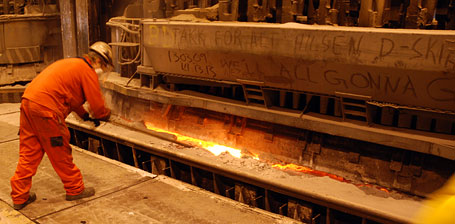On Friday, March 13, at 09.01 am, the power in the Søderberg potroom at the aluminium plant at Karmøy in Norway was switched off. This marks the end of production in the very last electrolytic cell in Hydro to use the old Søderberg technology.
 Before Søderberg cell B13 was attended to for the last time at Karmøy on Friday, D shift had written their farewell message in the dust: "Thanks for everything. Greetings from D shift. All gonna go." (All photos: Svein Erik Wiksnes)
Before Søderberg cell B13 was attended to for the last time at Karmøy on Friday, D shift had written their farewell message in the dust: "Thanks for everything. Greetings from D shift. All gonna go." (All photos: Svein Erik Wiksnes)
Environmental step
With the closure of its Søderberg production, Hydro has met important environmental requirements. But Friday’s closure of the Søderberg potroom at Karmøy was in essence marked by sadness.
The phasing out of Søderberg technology at Hydro’s Norwegian plants in recent years has brought the loss of many hundreds of jobs.
Once the biggest in Europe
When Hydro’s then CEO Rolf Østbye announced on June 11, 1963, that the company was going to build an aluminium metal plant at Karmøy, the flags were hoisted to the top of the pole locally.
A quarter of a century later, following the fourth extension in 1987, the Karmøy plant emerged as the biggest in Europe with an annual production of 220.000 tonnes.
But nothing lasts forever. The new millennium commenced with new and more stringent environmental specifications issued by the Norwegian Pollution Control Authority (SFT), and Hydro decided to phase out the older production technology, which uses open Søderberg cells, at its Norwegian plants.
In Årdal and Høyanger the Søderberg cells were switched off a while back. In Karmøy’s case the Søderberg cells were to be discontinued by the end of 2009. But the global financial crisis that started last autumn speeded up the closure.
Friday, March 13, marked the definitive end of the Søderberg era at Karmøy as well. Pensioned control room operator Audun Fatland and Jens Inge Ve, responsible for the electrical installation at the plant, saw to it that the switch was pulled that cut the power supply to the last cells in potroom B in the Søderberg facility.
New forward-looking technology
With the closure at Karmøy all Søderberg technology is now history in Hydro. Primary aluminium is produced exclusively using prebake technology at the Hydro plants in Høyanger, Årdal, Karmøy and Sunndal.
Indeed, in Årdal test cells are in operation that use HAL4e, the advanced electrolytic technology developed by Hydro that represents a further step on the road towards greater energy efficiency, even fewer emissions and the concentration of CO2 for future capture and sequestration when this is technologically and financially feasible.
Hydro may have given up the old Søderberg-technology, but has by no means given up producing aluminium and constantly improving production technology.
Gladness and sadness
In terms of greenhouse gas emissions and environmental considerations, many will look upon Friday, March 13, 2009, as a happy day. For the Hydro employees who have worked shifts in the Søderberg potrooms, the day was also marked by reflection and sadness because of the jobs that have gone and the ties between colleagues that have been severed.